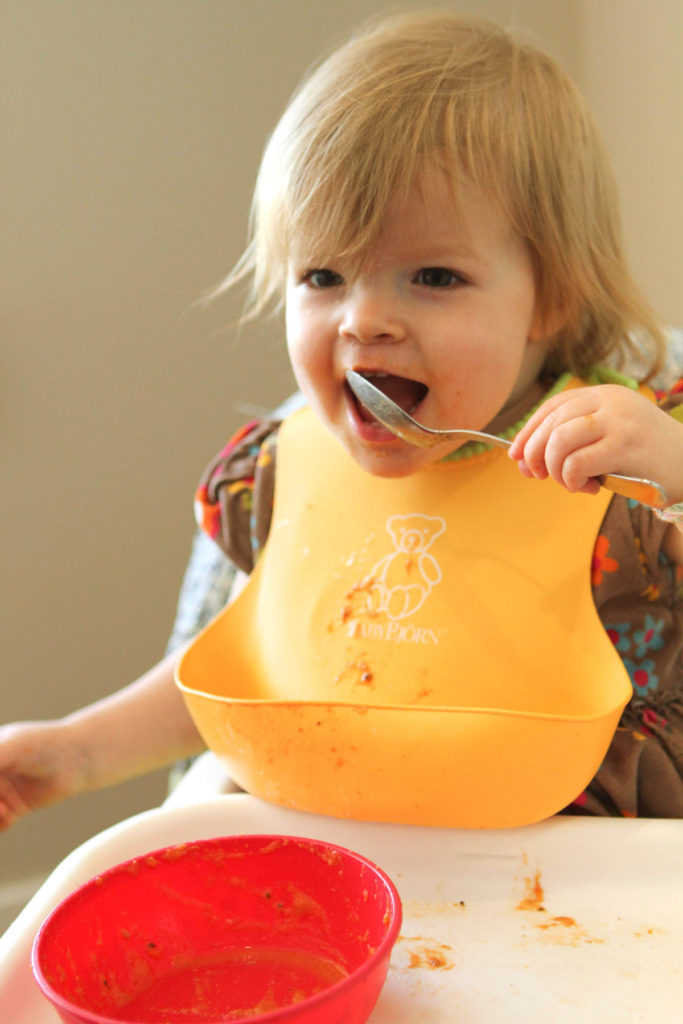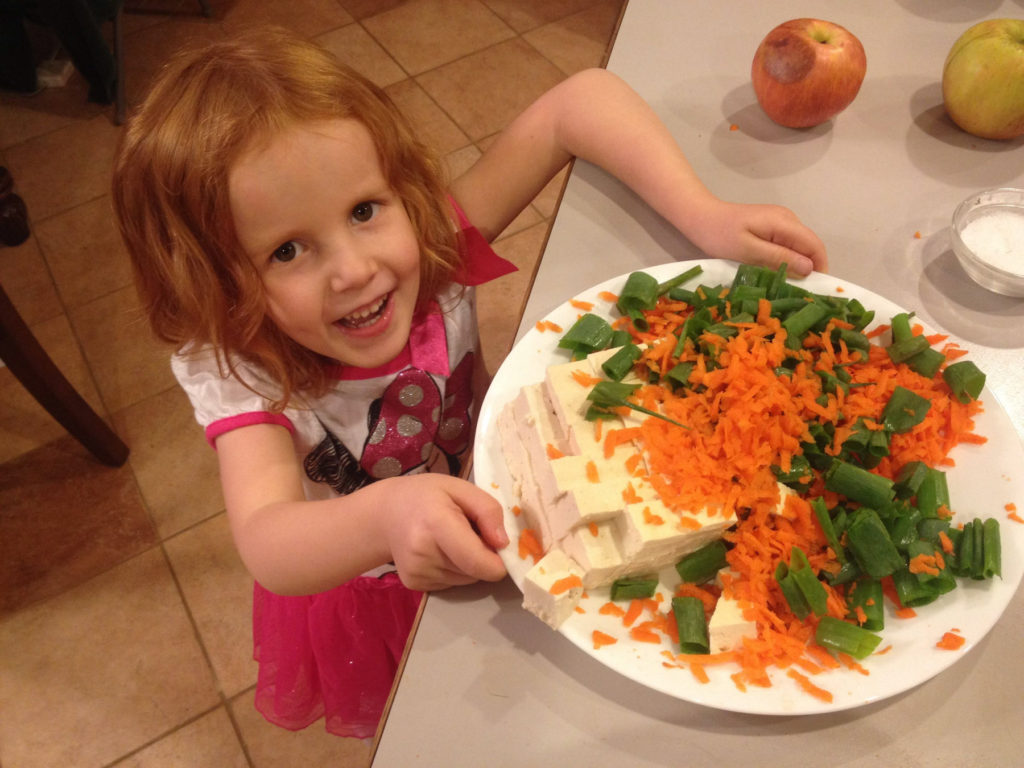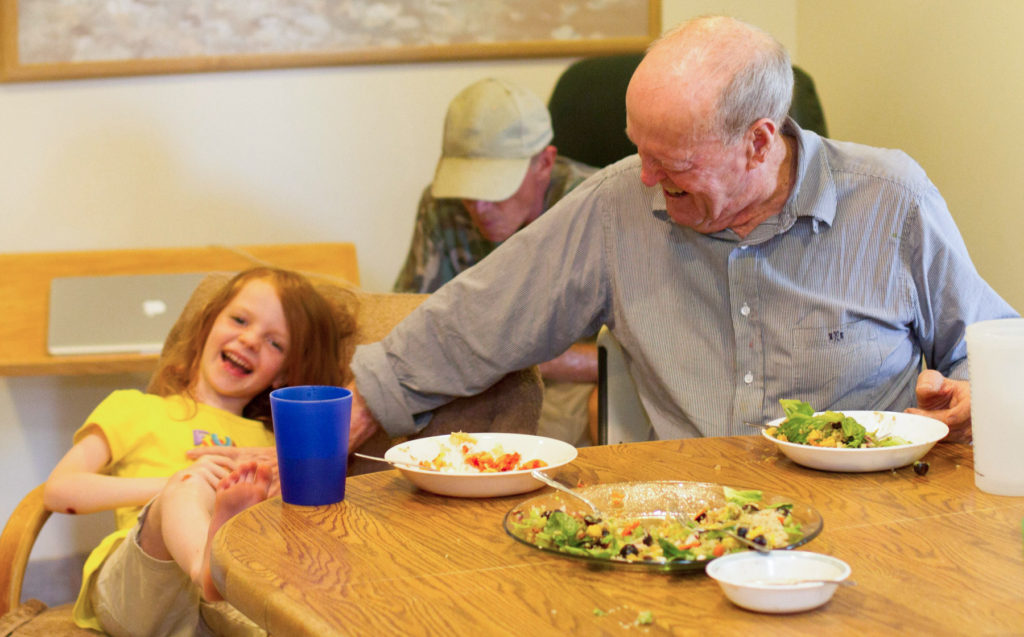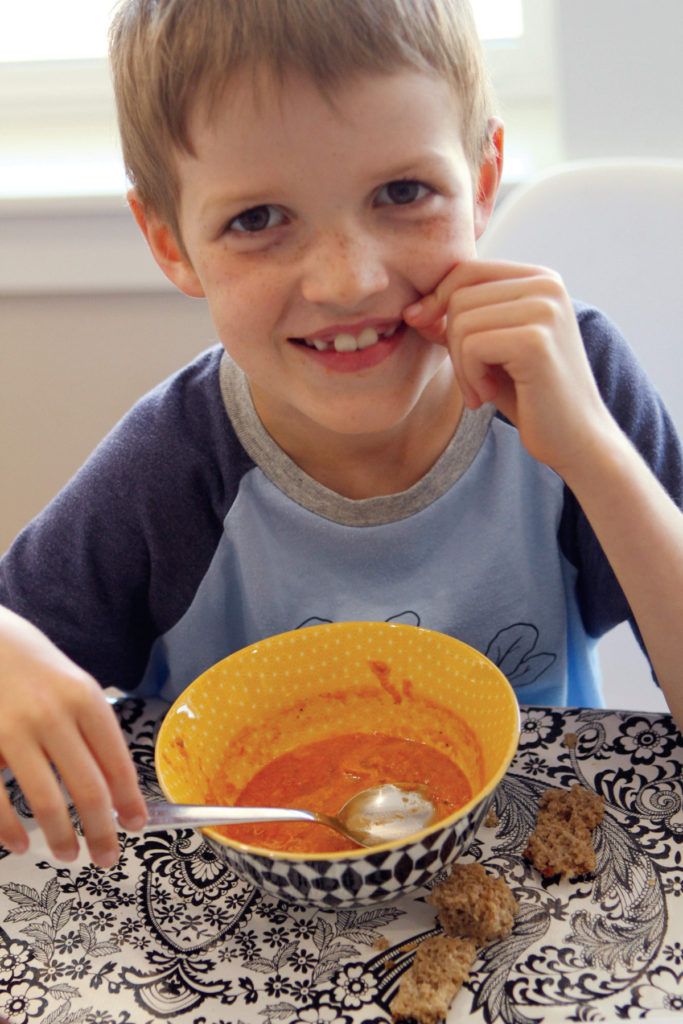
I have five children and the pre-dinner hour can be chaotic. People are hungry, we’re hustling to get the house picked up before Dad makes his much-anticipated appearance, I’ve got multiple pans in the fire (sometimes literally!) and everyone’s nerves seem a bit raw.
But most nights there’s a glittering reward coming. The reason why I bother cooking and being in the thick of things in the kitchen with my kids is those upcoming golden moments sitting around the table with them. There’s good food, good conversation, and good vibrations. It’s pleasant.

Or rather, it can be pleasant. Ahem. But if there’s grumbling, pouting, wandering off, interrupting, falling out of one’s chair, spills and constant hopping up, it’s less peaceful than it could be and more painful than it needs to be.
I get a kick out of this poem:
A child should always say what’s true
And speak when he is spoken to,
And behave mannerly at table;
At least as far as he is able.
Robert Louis Stevenson
We have two kids with ADHD, and our ages span 1-12, so the last line of that poem sure rings true around here. Kids aren’t adults, and their table manners won’t be perfect! But, here are 7 principles I’ve found that help kids behave their best at the table and make the meal more enjoyable for their parents as well.
1. Start the meal on the right foot
Until I started following this guideline, I was hopping up and down constantly during a meal. Someone always seemed to need something the instant I sat down, and I spent dinnertime more like a waiter than a participant in the meal.
Now? I take a minute to ask if anyone needs anything before I sit down. All drinks, silverware, bowls of soup are distributed before I take my seat. And then? I don’t get out of my seat until I offer “seconds” to the family*.
If someone forgot to grab something, wants a different sized spoon, or wolfs down their burrito before I finish chewing my second bite, they wait until I call for seconds.

Even my toddlers adjust to this and learn to wait, though I have them sit next to me at the table, so I can reach over to help them with some things without getting up.
Waiting for seconds also lets the foods settle in stomachs a bit, and register as “full” to our brains, which helps us all eat an appropriate amount.
*I do get up for actual emergencies, which do sometimes happen with a bunch of kids…
A similar principle applies to my kids taking their seats: They know they need to wash their hands and address any bathroom needs before joining us at the table.
Level Up: Teach your kids to wait to eat until everyone is seated. That’s good etiquette, and eating at the same time also allows them to see how you eat and mirror that.
Pro Tip: I’ll often set a timer halfway through the meal so I don’t forget to offer seconds, and the kids can relax about the possibility I might forget. (I may have forgotten a few times.)
Eating Out: My kids are far more patient in restaurants now, because they are used to having time just sitting patiently at the table rather than having their needs instantly met.
2. Nobody is allowed to criticize the food.
From the very beginning, I’ve taught my kids to say something positive or say nothing at all. If they are asked how they like the food, they know they can say “it’s not my favorite.”
I do value thoughtful feedback, and I’ll sometimes ask for further details, but I have never allowed them to say “yuck” or “gross” or “I don’t like that” to anything they are served.
This one practice has paid so many dividends!
It’s discouraging to someone (usually me!) who’s really tried to make something delicious, putting time and money and effort into it, to be met with careless disparaging remarks. Of course I can tell the foods my kids aren’t big fans of. I don’t need to hear griping about it.
It allows my kids to reserve judgement about something and to change their minds with dignity. They can think they won’t like something, try it, and find that they do without losing face because they proclaimed it “disgusting” on sight. It helps them keep an open mind!
We often host extra kids in our home through the Safe Families for Children program, so we have experience with helping kids quickly learn how to contribute to a great meal experience. I promise they can learn this!

Pro Tip: I highly recommend pro-actively teaching your kids to say “it’s not my favorite” at a neutral time, rather than try to just correct them into learning it. You don’t want this to be a battleground. It’s simply a life skill to be gracious when someone serves you food.
You can pretend to serve each other truly gross food and respond politely anyway. Just “thank you” with a smile, or you can challenge yourself to find something positive to save about almost anything they come up with! Keep it light but do be consistent once you’ve taught it, so they get in a new habit.
Eating Out: Naturally, this habit applies outside the home as well. I’m always embarrassed for kids when I see them responding at restaurants and friends’ houses in a hasty, impolite way. Kids often say the first thing that pops into their head, but if they are explicitly taught, and gently reminded, they’ll know how to be more agreeable.

3. Requests, not Demands

We teach our children to ask for what they want, rather than just append “please” onto a demand.
“More soup, please!” is a demand.
“May I please have more soup?” or “Would you please pass the soup?” are requests.
It seems like a subtle difference, but it makes a significant difference in the overall tone of dinnertime exchanges.
4. Meals can have a minimum length of time
I have some kids who would be inclined to say “I’m not hungry” or “I’m not eating” if it’s a new food, or one that’s not their favorite. Or on the flip side, some kids would bolt down their dinner without tasting it, and then tear off to do something else, or just plain wander off and claim hunger shortly after the meal is over.
If instead they know they are committed to the time sitting at the table, it’s amazing what foods they’ll try and what they’ll say in conversation.
Our children with ADHD especially benefit from these tips:
Set a timer at the very low end (maybe 7 minutes if that’s all they’re used to) and stretch it out slowly from there, adding a minute or two per meal.
Wiggly kids may need to push their plate backs when they’re through eating so they don’t flip their silverware onto the floor or knock over their glass with their elbow, but with practice they’ll get better about staying and engaging with the family for extended periods of time.
Send the wiggly kid to do all the errands at “seconds” time (and occasionally at other times if they’re looking especially restless). It gives them a positive, helpful reason to streak out of their chair, which is what they are burning to do anyway.
Reading a great book aloud as a family can hold the attention of a normally fidgety kid much longer, allowing everybody to enjoy the experience more. Pippi Longstocking is a great, silly way to begin reading aloud if this is new for you.
Eating Out: A child who is used to waiting at the table at home is better equipped to handle the wait times at restaurants.
Try playing an observation game when you go out. Have everyone else close their eyes and ask them “noticing” questions about their surroundings, such as “Did anyone notice how many chairs are at the table next to us?” or “Did anyone notice the wallpaper? Can you describe it?” They can have you take a turn as well. It can help kids feel interested and curious (and sometimes competitive) rather than bored and restless. Bonus: it teaches situational awareness.
5. Meals can have a maximum length of time
Here’s something to try with kids who tend to dawdle, so they learn to pick up the pace and you are spared the complaining at the end of the meal when they are caught off guard. Simply set a timer that’s a little bit of a stretch for them but still allows them time to eat enough, then subtract a minute or so every few days until you’re down to at a time you can both work with. For us that’s 30 minutes for breakfast or lunch, and 45 minutes for dinner.
The Slowey Joey will be reminded that the meal is moving along when you offer seconds, and sometimes you may want to give them a “five minutes left, finish your bites!” courtesy reminder as well.
Often a child won’t finish their food because they are busy talking during the meal. There are alternatives! These help with any chatty kid, including those who tend to talk with their mouth full.
Here again, reading aloud a great book a habit at the table is very effective, so the child’s only job is to listen and eat. This also gives the whole family something to talk about towards the end of the meal and a great shared experience to build upon.
Find another way to rotate who is speaking, so that kid’s mouth gets a break to put food into it. Perhaps go around the table answering a certain question, or sharing “high and low” parts of your day, so everyone gets a turn.
Start the meal with 5 minutes of silence. Sometimes with the flurry of activity before a meal, a kid may need time to settle into the task at hand without distraction.
6. Nothing but food at the table
No phones. No books (unless it’s a family read-aloud). No toys. Just the food and the faces of the people you love.
7. Make it wonderful
Do create systems and teach your children what you expect for mealtime behavior, but don’t be the etiquette police in the middle of the meal. The goal is for everyone to enjoy themselves. Here are some ways we facilitate that:

We try to include at least one food in the meal that is liked by all. Even if it’s just tucking a few apple slices onto the plate next to the new mushroom pasta dish, having a friendly familiar food does wonders for choosy kids as they warm up to the newcomer.
We try to use nonverbal reminders at the table. All I need to do is raise my eyebrows and make a silly alarmed face for my son to notice he got carried away with volume or activity level. He can then recover gracefully without a public scolding.
We do fun things periodically. One of my favorites is One Minute Speeches. They involve each person picking (or being assigned a topic), having one minute to prepare, and one minute to stand and deliver a speech. The topic might be “colors” or “trips you’ve taken” or “animals you’d like to see up close.” Almost any topic will yield wonderful results. We offer uproarious applause and specific compliments after each speech.
Bonus Tips
8. Set yourself up for success
Here are a few things you might consider to minimize (extra) mess and disaster at the table:
Buy cups that are less tippy. Shorter, with a nice base, filled with water (not milk or juice), no more than halfway full.
Get easy-to-clean chairs. If you’ve got kids, ditch the fabric chairs or the ones with the little grooves or rungs in the back that catch grime. After years of trying to cope with the ones that matched our dining table, we got smart and got ones like these instead (affiliate link). They’re wipeable and not tippy. We’re all more comfortable now.
9. Teach individual skills as needed
Teach your kids to sit on their bottoms and “belly up” to the table. You can role play this outside of mealtime. Make it fun and show both the wrong way and the right way.
Kids who know how to sit properly don’t fall out of their chairs (nearly as often), and don’t spill all down the front of themselves (again, as often.). We’ll also remind them sometimes to “mind the gap” because if they are sitting back from the table an awful lot of spillage can happen between the dish and the mouth!
Work with your kids on not interrupting. Again, do this at a neutral time not in the moment.
Talk about how nice it feels to be able to finish a thought completely, and do a silly role play where you interrupt each other like crazy.
Teach them how to get your attention instead, perhaps by placing a hand on your arm or by raising their hand at the table.
When it’s not in the middle of a meal, we have our kids run a number – their age in years – laps around a loop in our house (or do pushups or jumping jacks) when they interrupt. Most often they are interrupting because they are so excited to talk, and they learn that it takes much longer to get a chance to speak if they interrupt.
Consider having some “adult conversation” dinners, where the adults are talking and kids wait to speak until they’re directly asked a question. This is an old-fashioned idea, but we’ve found it’s a great opportunity for kids to learn some restraint and respect, as well as be able to hear the give and take of a mature conversation.

Teach your babies (at least) simple signs for the dinner table. It’s very easy to teach them to say “please” and it’s priceless not to be screamed at every time they would like something! I recommend “please,” “eat,” “thank you,” and “more” as a starting point. This will help bridge the frustrating gap between when they have very clear desires in mind and when they are able to articulate them so as to be understood.
10. Everybody Cleans
I usually don’t want more than a child or two in the kitchen with me preparing dinner, because it gets too crazy. But we do carry all those good feelings from the table over to cleaning up as a team. It’s a way for the rest of the family to thank those who made the meal, and we enjoy it.
We throw on a fifteen minute timer, some fun music, and we all jump in with our assigned jobs.
Teach your children how to help! They’ll feel good about contributing, and you’ll feel good about the state of your kitchen. Right now our table jobs are:
12 yo clears and wipes counters, puts away leftovers
9 yo does all the dishes
7 yo clears and wipes the table and chairs
4 yo picks up food that fell under the table
1 yo dances adorably to the music. Music is key!
Pro Tip: I find sticking with the same task for at least a year makes them an expert and eliminates the confusion and hassle of rotating.
Eating Out: Our kids are extra grateful to have someone else do the dishes when we eat at a restaurant, and they’re able and (usually) willing to help clean when we are guests in others’ houses.
Please share what works for your family in the comments.
And if you want help feeding your family more of a plant-based diet, you may want to stick around and check out my guide to picky eaters or my guide to transition your whole family to a plant-based diet.


